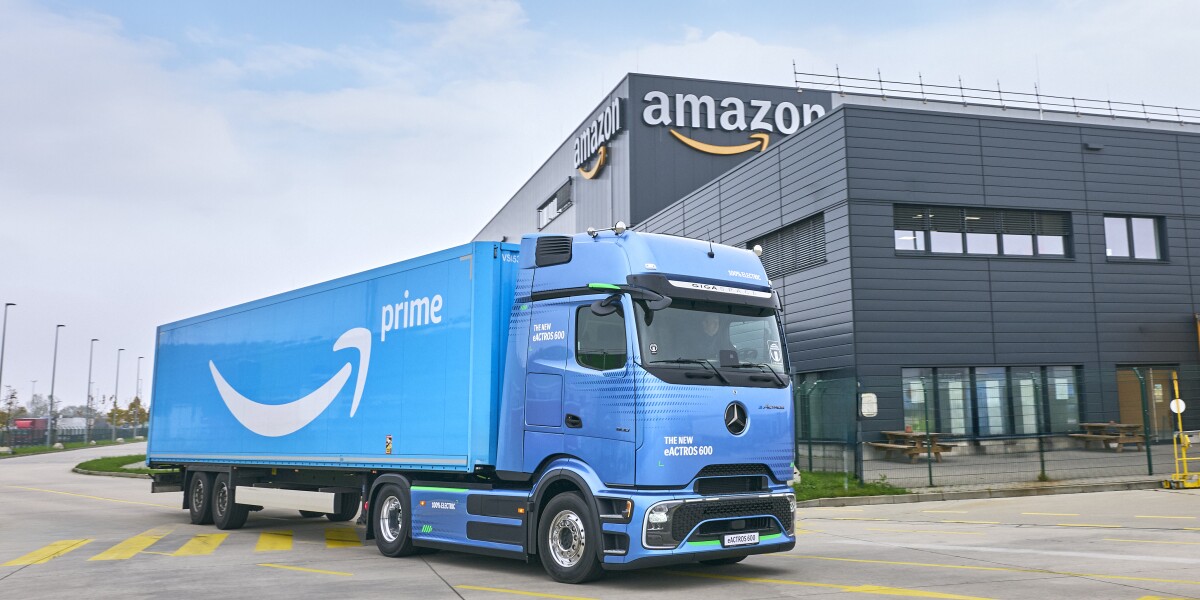While the European Union has made significant progress in strengthening electric mobility through ambitious policies, the industry still faces barriers to electric truck adoption and achieving global zero-emission freight goals. Urgent action is needed to develop charging infrastructure and create policies that support environmental objectives and industrial competitiveness.
Amazon’s approach and our call to action
We are already taking steps to decarbonize every leg of the transportation journey. In Europe, we’ve ordered 5,000 electric vans, bringing us to nearly 10,000 electric vans across the region by year end; we’ve begun to roll out 200 40-ton electric Mercedes-Benz trucks; and are delivering millions of packages to customers via micromobility solutions, such as pushcarts or electric cargo bikes. We’re also exploring solutions using hydrogen and looking to move more freight from road to rail. Investing in lower-carbon mobility helps to lower the EU’s energy dependency on imported fossil fuels, and position European manufacturers for global competitiveness.
While we are proud of these achievements to date, these solutions are not yet at scale. To reach their full potential, we need joint, urgent public-private partnership. That’s why Amazon has joined the E-Mobility E-Logistics Hub, a coalition of leaders and enablers in heavy-duty vehicle electrification, to call on European policymakers to create the enabling framework needed for this transition—our ambitions alone are not enough, we need to see action.
Shaping what comes next
Effective policy making can shape the competitiveness and speed of the e-mobility transition. The E-Mobility E-Logistics Hub propose the below tangible ideas which would support these objectives:
- Enable public charging: While the Alternative Fuels Infrastructure Regulation (AFIR), which mandates the installation of charging stations every 60 kilometers along major highways by 2026, is a great achievement, countries still need to implement it harmoniously across borders. The next step for AFIR should include megawatt chargers. The EU Grids Package and the Sustainable Transport Investment Plan (STIP) must enable faster power network upgrades and charger deployment.
- Close the cost gap: The Eurovignette Directive, which sets common rules for HDVs such as distance-based road charging and time-based user charges (tolls and vignettes), requires tolls to reflect the carbon footprint of heavy-duty vehicles. Developing and properly implementing this legislation harmoniously across the EU is critical. Another element is to address the high cost of public charging, which can be more than double the cost of charging at a depot. The EU needs to create an environment in which charge point operators can recuperate their investments, while allowing e-truck operators to work cost-effectively.
- Give vehicle makers certainty: The current CO2 emission standards for heavy duty vehicles are at risk. The standards have catalyzed the industry since its adoption and rolling it back threatens truck makers, logistics operators, battery suppliers and infrastructures providers’ ability to invest in future growth. We urge the EU to maintain a clear focus in electrification for the CO2 emission standards and provide the industry with certainty in the bloc’s commitment to a lower-carbon future.
- Implement harmoniously: Beyond making good policy, balanced implementation is equally important. Zero-tailpipe emission trucks need to cross EU borders without facing vastly different rules on how they can operate.
- Making the E-infrastructure smarter: At the infrastructure level, we should prioritize proactive grid investment based on future growth projections, ensure the EU Grid Action Plan delivers real-world results, streamline grid connection processes, and leverage digital technologies to enhance overall efficiency.
These measures, in addition to strong grid buildout, more transparency on grid capacity, and closer cooperation and partnerships between utilities, system operators, and end users, will make European mobility more competitive and sustainable. They will also enable Amazon to provide the best service to our customers across the continent, stick to the Green Deal ambition, and address the remaining barriers.
